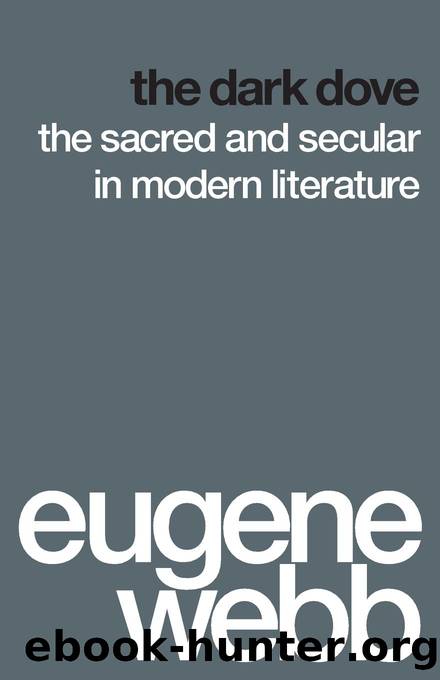The Dark Dove by Webb Eugene;

Author:Webb, Eugene;
Language: eng
Format: epub
Publisher: University of Washington Press
Published: 2014-08-15T00:00:00+00:00
1. James Joyce, A Portrait of the Artist as a Young Man (New York: Viking Press, 1964), p. 171. Subsequent references in parentheses.
2. For Joyceâs use of the term see Morris Beja, Epiphany in the Modern Novel (Seattle: University of Washington Press, 1971), pp. 71-111.
3. Quoted in Frances M. Bolderef, Hermes to his Son Thoth: Being Joyceâs Use of Giordano Bruno in Finnegans Wake (Woodward, Pennsylvania: Classic Non-fiction Library, 1968), p. 39.
4. New York: Vintage Books, 1961, p. 28. Subsequent references in parentheses.
5. New York: Viking Press, 1958, p. 53.
6. Letter to Ibsen, March, 1901, Letters of James Joyce, ed. Stuart Gilbert (New York: Viking Press, 1957), p. 51. See also Richard Ellmann, James Joyce (New York: Oxford University Press, 1965), pp. 89-91. The most extensive study of the influence of Ibsen on Joyce is Bjørn J. Tysdahl, Joyce and Ibsen: A Study in Literary Influence (Oslo: Norwegian Universities Press, 1968).
7. The Critical Writings, ed. Ellsworth Mason and Richard Ellmann (London: Faber and Faber, 1959), p. 40.
8. Finnegans Wake, p. 540.
9. Ibid., p. 23.
10. Ibid., p. 246.
11. Richard Ellmann, Ulysses on the Liffey (New York: Oxford University Press, 1972), pp. xv-xvi.
12. Letters of James Joyce, vol. 2, ed. Richard Ellmann (New York: Viking Press, 1966), pp. 168, 209.
13. Arthur D. Imerti, introduction to Bruno, The Expulsion of the Triumphant Beast (New Brunswick, N.J.: Rutgers University Press, 1964), pp. 35-36.
14. Ellmann, James Joyce, pp. 168, 178, 352-53.
15. Stanislaus Joyce, My Brotherâs Keeper: James Joyceâs Early Years (New York, 1958), pp. 103-4, quoted in Beja, Epiphany, p. 71.
16. See Reeves, Prophecy in the Later Middle Ages, pp. 96, 523.
17. Robert M. Adams, Surface and Symbol: The Consistency of James Joyceâs Ulysses (New York: Oxford University Press, 1962), p. 125.
18. Letter of ca. August 12, 1906, Letters 2:148.
19. See Reeves, Prophecy, p. 511.
20. Edom is a mistake on Bloomâs part, what Richard Ellmann calls a âBloomism.â See Ellmann, Ulysses on the Liffey, p. 36.
21. âEquine,â which seems rather odd in this context, may be an allusion to Brunoâs discussion of metempsychosis, in which he speaks of âequineâ and âporcineâ modes of existence; see Imerti in Bruno, Expulsion, p. 35.
22. Ibid., pp. 35-36.
23. Quoted in Ellmann, James Joyce, p. 351.
24. The New Science of Giovanni Battista Vico (1744), trans. Thomas Goddard (Ithaca, N.Y.: Cornell University Press, 1948).
25. It is perhaps worth noting that Mollyâs birthday, September 8 (p. 720), is also the day of the Feast of the Blessed Virgin Mary.
26. Ellmann, Ulysses on the Liffey, pp. 159-62, discusses various approaches to the ending of Ulysses.
27. It is perhaps worth mentioning that one of the mythic parallels I have not discussed in this chapter is that of Stephen to Christ. There are numerous links between Stephen and Christ, such as the Palm Sunday imagery in the Aeolus episode and references to the passion in the Circe episode. The reason I have not discussed them in connection with my theme is that whereas the parallels between Bloom and Christ have a positive significance, the parallels
Download
This site does not store any files on its server. We only index and link to content provided by other sites. Please contact the content providers to delete copyright contents if any and email us, we'll remove relevant links or contents immediately.
4 3 2 1: A Novel by Paul Auster(11788)
The handmaid's tale by Margaret Atwood(7447)
Giovanni's Room by James Baldwin(6808)
Asking the Right Questions: A Guide to Critical Thinking by M. Neil Browne & Stuart M. Keeley(5355)
Big Magic: Creative Living Beyond Fear by Elizabeth Gilbert(5351)
Ego Is the Enemy by Ryan Holiday(4956)
On Writing A Memoir of the Craft by Stephen King(4661)
The Body: A Guide for Occupants by Bill Bryson(4580)
Ken Follett - World without end by Ken Follett(4443)
Bluets by Maggie Nelson(4260)
Adulting by Kelly Williams Brown(4232)
Eat That Frog! by Brian Tracy(4148)
Guilty Pleasures by Laurell K Hamilton(4116)
White Noise - A Novel by Don DeLillo(3829)
The Poetry of Pablo Neruda by Pablo Neruda(3813)
Fingerprints of the Gods by Graham Hancock(3733)
Alive: The Story of the Andes Survivors by Piers Paul Read(3729)
The Book of Joy by Dalai Lama(3695)
The Bookshop by Penelope Fitzgerald(3618)
